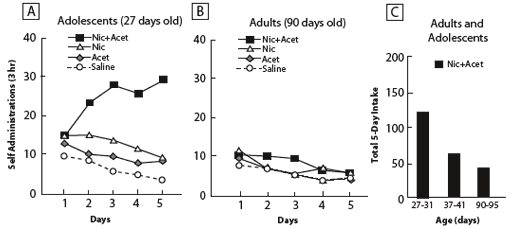The teen years are when most smokers first light up, and adolescents become addicted to tobacco faster than adults. Research has suggested that young people are particularly vulnerable to smoking addiction in part because their brains are more sensitive to nicotine, but that other factors also contribute. Now, NIDA-funded investigators have produced evidence pointing to another chemical constituent of tobacco smoke, acetaldehyde, as one of those factors. A recent study demonstrated that in adolescent but not adult laboratory rats, acetaldehyde and nicotine together produce a much stronger pleasure-producing, or reinforcing, effect than either chemical alone.
Dr. James Belluzzi and colleagues at the Transdisciplinary Tobacco Use Research Center at the University of California at Irvine hypothesized that acetaldehyde might play a role in smoking addiction for several reasons. Among them:
- Smokers exhibit more drive to take another puff on a cigarette than laboratory animals do to push a lever for another nicotine infusion, a difference that might be explained if smoke contains an additional reinforcing constituent besides nicotine;
- Smokers are abundantly exposed to acetaldehyde, which occurs naturally in tobacco leaves and also is formed as a combustion product of sugars added to tobacco during cigarette manufacture;
- Research has suggested that acetaldehyde, which also is produced during alcohol metabolism, contributes to alcohol reinforcement and withdrawal symptoms, raising the possibility that it might play a similar role in tobacco dependence.
 Adolescent Rats, but Not Adults, Increase Intake of Nicotine When it Is Combined With Acetaldehyde, a Component of Tobacco Smoke.(A) Adolescent rats self-administered nicotine combined with acetaldehyde—but not nicotine alone, acetaldehyde alone, or saline—with increasing frequency over 5 days. (B) Adult rats did not demonstrate any preference for nicotine, acetaldehyde, or the combination over saline. (C) Total 5-day intake of nicotine plus acetaldehyde was greatest for the youngest group of animals, suggesting that vulnerability to tobacco addiction decreases with age.
Adolescent Rats, but Not Adults, Increase Intake of Nicotine When it Is Combined With Acetaldehyde, a Component of Tobacco Smoke.(A) Adolescent rats self-administered nicotine combined with acetaldehyde—but not nicotine alone, acetaldehyde alone, or saline—with increasing frequency over 5 days. (B) Adult rats did not demonstrate any preference for nicotine, acetaldehyde, or the combination over saline. (C) Total 5-day intake of nicotine plus acetaldehyde was greatest for the youngest group of animals, suggesting that vulnerability to tobacco addiction decreases with age.To test their hypothesis that acetaldehyde contributes to tobacco addiction, particularly in adolescents, Dr. Belluzzi's research team conducted an animal self-administration study with early-adolescent (27-day-old), adolescent (37-day-old), and adult (90-day-old) rats. The researchers placed the animals in cages where they could poke their noses through holes in the cage wall to obtain injections of nicotine (30 mg/kg) plus acetaldehyde (16 mg/kg), nicotine or acetaldehyde alone, or saline. In such studies, the frequency and persistence with which animals nose-poke for a particular substance is a measure of how rewarding it is for them, which in turn may correspond to how addictive it is for people. Over the course of five daily 3-hour sessions, the youngest rats worked up to poking their noses for nicotine plus acetaldehyde roughly three times as frequently than for either chemical alone or saline. The older adolescent rats also demonstrated a preference for the two-drug combination, but a less-marked one than the 27-day old animals. The adult rats responded no differently to the drugs, alone or in combination, than they did to the saline solution.
"Our results show that acetaldehyde, at the same relative concentration found in cigarette smoke, dramatically increases the reinforcing properties of nicotine," says Dr. Belluzzi. "Furthermore, the effect is age-related, with adolescent animals far more sensitive than adults."
To buttress their interpretation of their results, the researchers tested a potential alternative explanation for the rats' behavior: The animals might not be seeking pleasure when they poked their noses into the holes for nicotine and acetaldehyde, but simply exhibiting random activity due to chemically induced locomotor stimulation. To evaluate this possibility, the researchers put a control group of rats into the test cages and gave them injections of nicotine plus acetaldehyde at the test dosage. They predicted that these rats should nose-poke less than the original animals if pleasure-seeking was a main motivation for the behavior (because they were getting the chemicals' reinforcing effects automatically without having to work for them), or nose-poke the same amount if locomotor stimulation was the primary cause (because the test animals and control animals received similar doses of the chemicals). The data showed that the control rats nose-poked less than the original animals.
"This research underscores the point that nicotine alone may not cause the intensity of dependence seen in smokers, and nicotine replacement does not, by itself, eliminate withdrawal or craving for people trying to quit. Other factors clearly are at play," says Dr. Allison Chausmer of NIDA's Division of Basic Neurosciences and Behavioral Research. "Dr. Belluzzi's experiment strongly suggests that acetaldehyde is one of those factors, and it offers a potential explanation for age-related differences that we observe in epidemiological studies of the impact of tobacco."
Source
- Belluzzi, J.D.; Wang, R.; and Leslie, F.M. Acetaldehyde enhances acquisition of nicotine self-administration in adolescent rats. Neuropsychopharmacology 30(4):705-712, 2005. [Abstract]